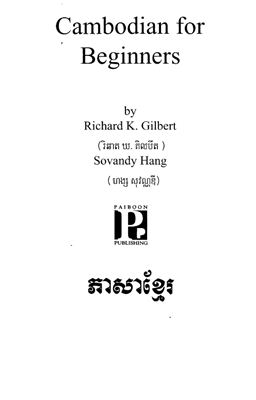Paiboon Publilshing, 2004. - 289 p.
Cambodian for Beginners is easy to use and easy to understand. It teaches the four basic language skills: speaking, listening (with the compact discs), reading, and writing. The first part of each lesson teaches vocabulary and sentence structure. As a helpful tool, a vocabulary list with Cambodian spelling, transliteration, and English definitions appears at the beginning of each chapter.
The second part of each lesson teaches students how to read and write. At first glance, the Cambodian script looks exotic and difficult to understand, and many students wonder if it is worth the trouble. Their primary goal is to lea how to hold an effective conversation, so why go to all the trouble of leaing the alphabet? Through these lessons, though, students quickly discover that leaing the script is much easier than it looks. Written Cambodian uses no spaces between words. But we do put spaces in, so that beginning students can master the script more easily. Students also quickly discover that leaing the Cambodian alphabet is indeed worth the trouble. Because the written language is almost entirely phonetic, leaing the alphabet greatly facilitates pronunciation and comprehension. So we begin teaching the Cambodian alphabet from the very first lesson.
Cambodian for Beginners is easy to use and easy to understand. It teaches the four basic language skills: speaking, listening (with the compact discs), reading, and writing. The first part of each lesson teaches vocabulary and sentence structure. As a helpful tool, a vocabulary list with Cambodian spelling, transliteration, and English definitions appears at the beginning of each chapter.
The second part of each lesson teaches students how to read and write. At first glance, the Cambodian script looks exotic and difficult to understand, and many students wonder if it is worth the trouble. Their primary goal is to lea how to hold an effective conversation, so why go to all the trouble of leaing the alphabet? Through these lessons, though, students quickly discover that leaing the script is much easier than it looks. Written Cambodian uses no spaces between words. But we do put spaces in, so that beginning students can master the script more easily. Students also quickly discover that leaing the Cambodian alphabet is indeed worth the trouble. Because the written language is almost entirely phonetic, leaing the alphabet greatly facilitates pronunciation and comprehension. So we begin teaching the Cambodian alphabet from the very first lesson.

